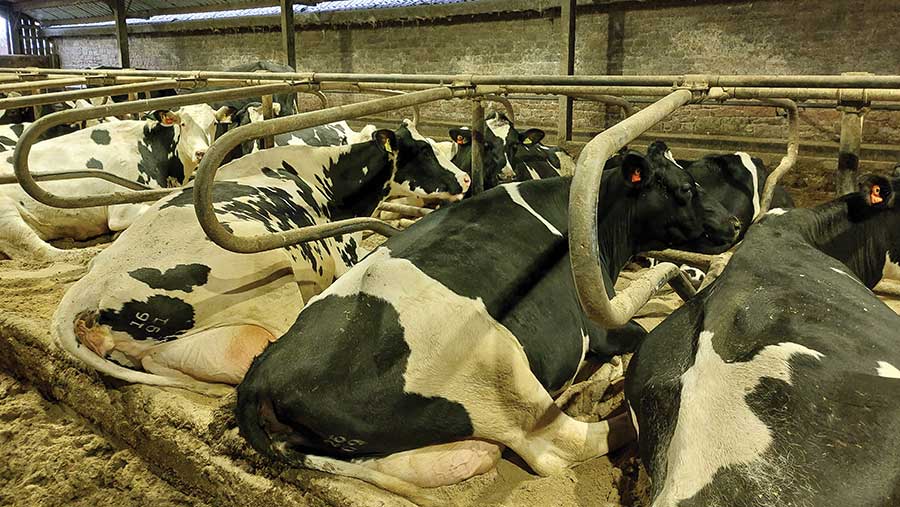How high-yielding dairy cut soya and lowered crude protein
 © MAG/Shirley Macmillan
© MAG/Shirley Macmillan Removing soya feeds and unnecessary additives from the diet, as well as steadily reducing crude protein levels, have been done without increasing farm costs or compromising production in one Dorset herd.
In fact, since relocating from Oxfordshire in 2011, Stuart Rogers has managed to raise milk yield from 9,000 litres to 11,400 litres – still on twice-a-day milking.
A breeding policy switch from focusing on type, to include functional health traits alongside production, has improved health as well. Cell counts have fallen by more than one-third, to 69,000 cells/ml.
See also: Lower-protein dairy feed could cut costs and ammonia emissions
However, it is Stuart’s attention to the details of feeding, housing and youngstock rearing that has allowed cows to express their genetic potential.
Shortly after moving in, he and his father, Colin, decided to work with the farm’s existing cubicles and troughs for the milking herd, but add a new heifer shed – featuring smaller cubicles – and dry cow accommodation.
Both sets of cubicles were installed on sand bedding, and the milking cows were switched over in 2012. This has helped with mastitis control.
Calves on total mixed ration
Stuart’s aim with the heifer shed was to train replacements onto the herd system. He believes good feeding starts with calves, and that a total mixed ration (TMR) from the age of six weeks is the best way to achieve this.
“They are reared in pairs from two weeks of age, then weaned into groups of six on straw yards and go into cubicles at six months. We weigh them monthly and move them on a weight basis,” he says.
The result is that he gets no setbacks when heifers join the main herd after calving. And first lactations average more than 9,500 litres. “They get the same attention to detail as the milking cows,” he adds.
Farm facts
Longmoor Farm, Gillingham, Dorset
- 125ha tenanted of which 73ha maize, 52ha grass
- 240 Holstein cows
- 150 heifer replacements
- 11,400 litres at 4.36% fat and 3.44% protein
- Milk from forage 4,300 litres
- Replacements bred out of £600PLI cows using sexed semen
- Beef Longhorn genetics over rest of herd
- Four full-time staff
- Supplies Waitrose via Muller
Stuart does most of the feeding, for consistency and accuracy. To improve intakes, he decided to feed the high-yielding group twice a day in the troughs.
“Judging [intakes] for 24 hours was tricky, and this made it easier to avoid lots of leftovers.
“Also, with a 24-hour ration, what the cow eats in the first two to three hours is a very different ration to the last two to three hours, due to sorting,” he explains.
“If someone else comes in to feed, they have got to ‘read’ the troughs: if cows empty the trough and are lying down content, that’s OK. It’s finding the sweet spot. If dry matter intakes are good, everything else falls in behind.”
That is a view shared by his nutritionist, Christine Pedersen of The Dairy Group, whose remit is to produce a cost-effective diet for healthy, high-yielding cows.
“You can’t get performance without good health – and you won’t get good health without good nutrition,” she says.
Removing soya
The business has never fed very high crude protein levels, but the move to stop feeding soya and its derivatives was hastened by Stuart’s milk buyer.
He admits he was not sure how it would pan out, though he understood it was contributing to a higher ration cost and the farm’s carbon footprint.
Christine looked at alternatives such as rapeseed meal and maize distillers’ grains.
“It’s whatever works to complement the forages. Although rapeseed and maize distillers are cheaper on a £/t basis, we evaluate them on a nutrient basis,” she says.
“We were also feeding soya hulls, which were a cost-effective source of fibre; finding a replacement was more of a challenge. Now we use sugar beet pulp.” (see “Rations at Longmoor Farm”.)
Stuart stopped feeding soya and its derivatives in 2016 and has fed no rumen bypass fat for the past two years.
“It’s a simple ration of a pre-mix blend blown into bins, with maize and grass silages, water and minerals. No additives, bags of this and ‘magic’ that,” he says.

Stuart Rogers © MAG/Shirley Macmillan
“It’s how we want to run the dairy, so I’m pleased we are not feeding soya. We’ve got to be able to adapt to [changing] circumstances, not get hung up about chasing something.”
The farm’s multicut silage system starts in late April, taking five cuts across the season, to produce a consistent forage of 11.5-12MJ of metabolisable energy/kg dry matter with a uniform 15-16% crude protein (CP).
Christine formulates all diets to meet metabolisable protein rather than crude protein recommendations for heifers, dry cows and milkers – for growth or milk production. The diet is now 16% CP, having previously averaged 17%.
Excess protein excreted
Reducing CP in the diet helps further reduce feed costs and makes sure that excess protein is not simply excreted in the urine and slurry, says Christine.
“It doesn’t make sense to pile in protein – often the expensive part of the ration – and watch it being excreted, when there is no productivity or health benefit from feeding it.”
She adds, however, that there is “no silver bullet to lowering carbon footprint” and it has taken a lot of work targeting protein levels and tweaking feed inputs. (The blend without soya or soya hulls has a carbon footprint of 500kg carbon dioxide equivalent a tonne less than a similar blend with these ingredients.)
Stuart is constantly reviewing rations to improve efficiency and wherever possible lower protein further. “The feed costs less and we get the same results; if you do it sensibly, there are no negative effects,” he says.
He says there is a constant feedback loop between him and Christine as they monitor milk analysis or urea readings. Forage is re-analysed monthly, and the formulation of the blend can be tweaked for the next delivery.
.
“We monitor milk urea results – the target is 0.02% – as a sense check between the ration on paper and what it delivers. We buy a blend to work with our forages and monitor the natural variability in a blend,” he says.
Rotational grazing
With the same attention to detail he pays to the TMR, Stuart has also set up a grazing platform. Milking cows must have 183 days of grazing a year to satisfy his milk contract.
Earmarking 49ha (121 acres) of grassland to convert into paddocks that offer flexible cutting and grazing, he added a network of tracks in 2018 to access grazing in wet weather. And, in 2022, he replaced electric fencing with hedges to offer shade and shelter.
“The doors are open for at least six hours. We notice that fresh cows go out for less time, then come in to get their ration. Stale cows go out when it’s early and we shut them out on grass.”
Rations (dry matter) at Longmoor Farm
High yielders
- 10.5kg maize silage
- 2kg grass silage
- 12.5kg of a blend based on rapeseed meal, wheat, sugar beet pulp, maize distillers, biscuit meal plus molasses, minerals, a rumen buffer and urea
- Cost: 10.25p/litre
Low yielders
- 6kg maize silage
- 7.7kg grass silage
- 7kg of blend and minerals
- Cost: 7.75p/litre
